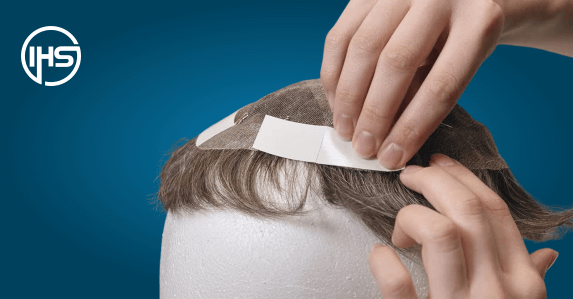



Contact our specialists now for Hair Replacement!
When it comes to hair replacement systems, durability is everything. Yet, wearers repeatedly complain about the PU (polyurethane) coating refusing to bond properly with tape.
We remember a conversation we had with one of our clients, David, whose hair system kept lifting no matter how often it was re-taped. It turned out that the PU coating on the base was rejecting the adhesive altogether. The problem wasn’t the tape. It was the coating itself!
PU is smooth. Adhesive tapes, especially those used in hair systems, rely on surface texture to grip. Ever tried sticking sellotape to glass? It holds, but barely.
But why does this happen? Let us understand!
PU coating, which stands for Polyurethane, is a thin, flexible layer applied to the base of a hair system. It creates a smooth, skin-like surface that replicates the scalp, making the hair system more durable and easier to attach.
PU coating serves multiple purposes. Depending on the hair system’s design, it is mainly applied around the perimeter (also called the periphery) or across the entire base. This coating strengthens the support, making using and removing adhesive tapes easier. It also offers a stronger hold and better durability.
One of the considerable points of PU coating is its natural-looking finish. The transparent layer mixes well with the scalp, making the hair system appear more realistic. Additionally, PU coating helps prevent shedding by sealing the knots where the hair strands are tied, reducing the risk of hair loss from the system.
PU-coated bases are also easy to clean and maintain, making them popular for people who frequently wear hair systems.
Hair systems typically consist of a base material made from lace, monofilament, or polyurethane (PU). However, not all base materials are suitable for direct tape application.
Many men’s and women’s hair systems come with tape surfaces with specific zones supported with PU coating.
PU coating is commonly used because of its smoothness, making it ideal for tape adhesion.
The placement of tape surfaces changes depending on the style and coverage of the hair system.
For instance:
Perimeter Tape Surface: Many hair systems have a PU-coated perimeter, making applying tape along the edges easier. This structure offers a secure fit and is commonly used in men’s hair systems designed for full or partial coverage.
Something you need to know – Polyurethane or silicone are used for tape surfaces in hair systems, as these materials prevent slippage and offer reliable adhesion.
However, using tape directly on delicate lace bases without a tape surface can damage the lace and reduce the system’s longevity. That’s why many hair systems incorporate PU-coated areas specifically for tape application.
We have spent years perfecting our PU coating and tape techniques, so you never have to worry about lifts, slips or adhesion issues.
This expertise allows us to provide high-quality hair systems that stay secure, comfortable, and long-lasting. Choose confidence, choose IHS London!

IHS Hair Replacement is a hair replacement brand based in 2 prime locations, West Kensington in West London and Liverpool Street in Central London. We provide a full head of hair achieved through our hair integration procedure giving you confidence and life.